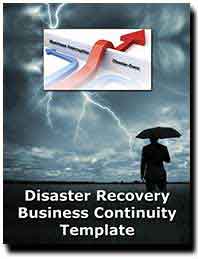 Top Ten Reasons that Recovery and Business Continuity Process Fail When Activated
Top Ten Reasons that Recovery and Business Continuity Process Fail When Activated
Despite preparations, many small and mid-sized companies do not survive in the wake of a disaster
 Top Ten Reasons that Recovery and Business Continuity Process Fail When Activated - As businesses in the Gulf Coast and in the fire and drought ravaged West are finding out again, having a disaster recovery plan is critical to a business' survival. Janco has found that 43 percent of businesses that close after a natural disaster never reopen, and an additional 29 percent permanently close within two years. However, in the wake of the ongoing financial crisis, many disaster recovery plans are now out of date, says Victor Janulaitis, CEO of Janco Associates.
Top Ten Reasons that Recovery and Business Continuity Process Fail When Activated - As businesses in the Gulf Coast and in the fire and drought ravaged West are finding out again, having a disaster recovery plan is critical to a business' survival. Janco has found that 43 percent of businesses that close after a natural disaster never reopen, and an additional 29 percent permanently close within two years. However, in the wake of the ongoing financial crisis, many disaster recovery plans are now out of date, says Victor Janulaitis, CEO of Janco Associates.
For insurers, the responsibility extends beyond operational data and systems, Janulaitis adds. “The real issue in the insurance industry is the statutory reporting that they have to do at the end of the year, and it's different for each one of the states,” he says. “They have to make sure they don't lose any of the statistics or data that they need for those reports, or else they have regulatory compliance issues they have to deal with. That's a mission-critical application for an insurance organization. ”
Even among those companies that do plan, disaster recovery and business continuity (DR/BC) plans often fail, Janulaitis says. Based on his experiences, Janulaitis has compiled a list of the 10 most common reasons disaster recovery and business continuity plans fail:
- Backups do not work
- Not identifying every potential event that can jeopardize the infrastructure and data upon which the enterprise depends.
- Forgetting or ignoring the cross-training of personnel in DR/BC.
- Not including a communication processes that will work when your communication infrastructure is lost.
- Not having sufficient capacity and duration of backup power.
- Having a recovery plan in place, but not listing priorities of which resources need to be restored first.
- No physical documentation of your DR/BC plan.
- Disaster recovery and business continuity plan that has not been tested adequately.
- Passwords are not available to the DR/BC team.
- Disaster recovery and business continuity plan is not up to date.
“If you go back to Katrina, the organizations that did not move their facilities out of New Orleans, very few of those organizations actually survived. The survival rate, if you haven't implemented a plan, for a small- or mid-sized company is fairly low,” Janulaitis says. “Organizations can't recover. They have lost all of their records, including lost intellectual property, customer lists, product catalogs - including artwork, and when you have anything that is water or fire related event, you have lost the physical devices. If you don't have a recovery plan in place for your electronic assets, you're out of business. There is only so much institutional memory that will help your organization survive.”
